The games master...
 Greg
Derrett has been rousing the crowds at the London International Horse Show competition at
Olympia since he was 18. Twenty years and scores of smoking runs later, in December 2012, Greg
became the only competitor in history to place first in both the Grade 6-7 and Novice
competitions at The Kennel Club Olympia Agility Finals. It was his sweetest victory ever. Sally
Silverman traces his agility career back to Olympia. Greg
Derrett has been rousing the crowds at the London International Horse Show competition at
Olympia since he was 18. Twenty years and scores of smoking runs later, in December 2012, Greg
became the only competitor in history to place first in both the Grade 6-7 and Novice
competitions at The Kennel Club Olympia Agility Finals. It was his sweetest victory ever. Sally
Silverman traces his agility career back to Olympia.
Greg Derrett wasn't
yet ten when his mother first took him to watch the horses at Olympia, a prestigious equestrian
competition, but it was the horses that caught his attention... it was the dogs.
He
saw the agility' and said ‘I want to do that.'
It was the early
days of agility, and young Greg was hooked.
Pursuing the dream
When he was 12, one of
his mother's friends had a litter of puppies. Greg was allowed to take one, with the promise
that he would train the dog. He did, and hasn't stopped training since.
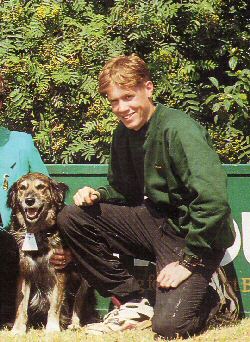 In
almost no time, Hettie, who was probably a Golden Retriever/Border collie mix, was winning
everything in local obedience club competitions. His instructors encouraged young Derrett to
pursue the new discipline of agility. He was a 12-year-old kid who could run fast and he was an
ideal candidate. In
almost no time, Hettie, who was probably a Golden Retriever/Border collie mix, was winning
everything in local obedience club competitions. His instructors encouraged young Derrett to
pursue the new discipline of agility. He was a 12-year-old kid who could run fast and he was an
ideal candidate.
The pair started to
rack up the wins and by 1991, at the age of 15, he was named Junior Handler of the Year.
'Once
you start winning, you get the bug. From the beginning, I wanted to go to Olympia and
compete, to do what I had seen there, in front of 10,000 spectators.
The same year he
turned 'pro,' offering agility lessons to pay his way through college.
Developing a training philosophy
Greg's university
studies were centered on companion animal behaviour, earning him an Advanced degree, which is
comparable to the Bachelor of Science in the United States.
'A
lot of people tend to do different things on different days. Because I come from a more
scientific background, dog training has to make theoretical sense. I take a more scientific
approach, trying to keep things more mathematical.'
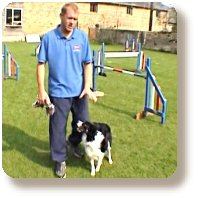 That
mathematical bent has influenced all of his training ever since. That
mathematical bent has influenced all of his training ever since.
Borrowing from the
mathematical, Greg devised his own equation that is at the heart of all of his foundation work,
specifically: cue= behaviour = reward. This is the place where he sees the biggest holes in
training, creating the most problems for handlers.
'People don't put
enough effort into their reward structure and, therefore, aren't creating the right
reinforcement. It's important to make sure that the reinforcement you are offering is a real
reward to the dog, as well as a practical to use in training. When we start training, I make
sure that I have the million dollars that the dog wants.'
'A good trainer,' he
says, 'will work on those reinforcement structures throughout the dog's life. 'It means not
allowing bad things to become too rewarding—like fence running. And making sure that you are
the number one thing the dog wants.'
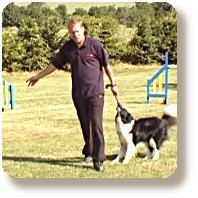 Take
tugging, for example. Greg says that he and wife Laura, his partner in training and teaching,
put massive amounts of time into tugging. 'The interaction with the handler is the reward, not
the toy. If I let go of the toy, my dog will try to put it back in my hand. It's really not
magic. It's just putting the time and energy into the activity so that the dog loves it.' Take
tugging, for example. Greg says that he and wife Laura, his partner in training and teaching,
put massive amounts of time into tugging. 'The interaction with the handler is the reward, not
the toy. If I let go of the toy, my dog will try to put it back in my hand. It's really not
magic. It's just putting the time and energy into the activity so that the dog loves it.'
And that's where it
starts.
'That is my real goal
with young dogs. I want them to think that I am fantastic.
'Once they do, he
teaches the sits, hand touches, and downs. 'Many people move on to this before they have the
reinforcement established.' It's the beginning of his goal to 'teach brilliance on the ground.
That way, by the time the dog gets to the equipment, he has all the skills he needs to win the
world cup. The rest is just wood and metal!
Take
time to train
Running UK
International (UKI) and UK Agility (UKA) trials, handling responsibilities with the World
Agility Open (WAO)—the international agility venue that he created and manages with
Monica Percival of Clean Run, conducting on-line training courses, and travelling three
months a year worldwide to present seminars, Greg is a busy man. It's imperative that he
be thoughtful in using the limited time he has to train his own dogs.
Training time for Detox may be
about a problem that he's had at a trial, some weakness or fault that he'll try to fix.
With the younger dog, it will be about bringing her up the levels. Winter training is a
lot about tidying up the elements of the dog's foundation. Training revolves mostly
around drills. |
 |
|
For the ten weeks
before the FCI Agility World Championships, Detox ran courses designed by the judges who
would be at Worlds. 'Anything that I was uncomfortable with, I would break down into
drills.'
He keeps a record
of what went wrong, and skills he is not satisfied with. He discovered that Rehab, for
example, had not been taught tunnel-contact discriminations so they have been working on
that.
'I keep all of
the drills in a folder so that I can reuse them on another dog, without creating a new
one. At a seminar, I might come across a problem and create a drill for the students and
then take that home. I have thousands of different drills in a folder on my desk in
‘Greg' language. They are in code, but I can decipher it!' |
 |
He keeps the dogs fit
by running them in the paddock for 20 minutes, going for good walks in the countryside and
letting them run around wooded areas near his home where they are able to jump trees and bend a
lot.
 Teaching
the teachers Teaching
the teachers
The USA, Belgium, New
Zealand, Australia... Greg travels the world teaching agility enthusiasts. Some come to argue,
he confesses, while others come to learn.
'That has helped
me tremendously as an instructor. In North America, they ask a lot more questions, and
they want you to have the answers. It's a challenge to be able to justify why. It has
really improved the presentation of our information. When students take what you have to
say as gospel it doesn't help you, as a teacher, to grow.'
While the students
range from novice to international competitors, he too often sees holes in foundation work
which all goes back to the foundations, groundwork and basic dog training skills. Shadow
handling, circle handling need to be looked at to solve a problem on a world-class course.
 Go
for the goal Go
for the goal
Goal setting is a
valuable part of training. While the average seminar participant that he works with is looking
to be the best that they can be, they all too often haven't set specific goals. Good goals are
those that are realistic for the dog and handler partnership.
'If someone wants to
compete in the World Championships and this is their first dog, the goal might be too high.
If you choose goals that are unrealistic, you are setting yourself up for frustration'
On the other hand, he
sees people who stay at a stage too long in order to perfect something.
'You need short-term
goals as well as long-term goals. It's the short-term goals that help a handler achieve the
long-term goals.
Quick-release contacts
are an example. The time for quick-release contacts would be at Worlds, 'but I have to win to
get there. So I will do the quick-release contacts and then go back to training at trials. I
have to make good dog training decisions.
'Being a great competitor doesn't necessarily come
with being a great trainer, and vice versa. 'The difficult part is finding that balance where
you are both, without losing the skills.'
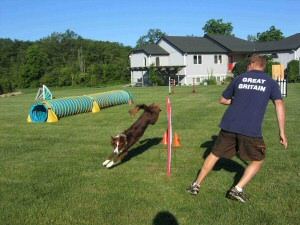 Reaching
the top Reaching
the top
For competitors
aspiring to the highest levels of handling, he has this advice: understand what that involves.
There is dog training and handling, of course. To that he adds the physical fitness of both the
dog and the handler, and a fair measure of sports psychology.
'I went to Olympia feeling as
though I was going to win both classes, and that makes a big difference. I do the hard work
that puts me in that position.' It means committing to a training strategy for three to four
years.'
And it means doing what
needs to be done outside of the formal training to prepare the dogs. He recommends taking young
dogs to competitions when older dogs are competing, and making sure that they are well
socialised. In preparing for Olympia, for example, he wanted Rehab ready. it was her first
experience in that kind of setting.
'I got into the arena
early, and had her playing in the stands. I wanted her to hear the crowd cheering, the noise
and the atmosphere.'
A successful competitor
also needs a good support team including a chiropractor and massage therapist for the dogs and
a group of people with whom to train.
 Getting
to Olympia Getting
to Olympia
In order to get to
Olympia, a competitor has to compete at Olympia qualifiers through the
year. From those
qualifiers, there are two semi-finals of 36 dog/handler teams. The top 18 teams have the
opportunity to compete in London.
Those teams—the top 36 from the Novice Level and the Large Competition—run in the morning at
Olympia, when spectators are few and the atmosphere is not as charged. It's the winners of that
heat, the top 10, that run in the final in the evening. And it is electric. While some of our
qualifiers have FCI-type technical challenges, the finals at Olympia are more open and less
technical. The organisers want the speed for the crowd. The competition course is set up
rapidly, finished in 20 minutes, and the winner enjoys a victory lap to the cheers of a wild
crowd. It's manic. It gives you a buzz. It's the closest thing you can get to a football
stadium atmosphere. Greg wouldn't swap an Olympia win for any international win.
Bringing it home
Though Olympia is
always a fast and furious run, Derrett has a strategy going in to the competition. Because the
winner of Round No.1 runs last in the finals, he tries to time it so he just makes the finals
cut, earning the first spot.
He says
'The reason I run early is that
if I put in a really good run, the following teams are under pressure. It's a strategy that
I've used for years i.e. reach the finals with a nice, steady clear round, then blow the
competition out of the water in the finals. I have been in the finals more than anyone else,
I think, and, whenever I've been there, I've finished in the top two. The tactic has always
worked.'
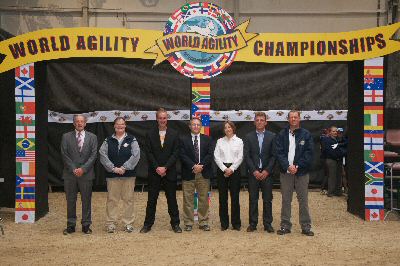 Influencing
the WAO Influencing
the WAO
If Greg serves as a
role model for thousands of agility competitors worldwide, Olympia is serving as his model for
the WAO event in Spain, May 18-20, 2013.
For instance, a
tunnel has been constructed so that the competitors will make a dramatic entrance into the
arena, just like at Olympia. There will be ring decorations. Olympia plays good music, to get
the crowd going. That's something he thinks should be done at more of at international events.
He even envisions a big light show in the future, and the opportunity for the winner to
have a victory lap in the spotlight.
'We also need to look
after both the winners and the losers. At Olympia, if you are eliminated, the crowd still
cheers.' They have engaged a professional DJ to bring upbeat music to the arena, even when a
team is eliminated. 'We want the agility competition to be more important than the crowd
atmosphere, but that crowd atmosphere actually helps the competitor.' It's his hope that the
WAO will have the same excitement and electricity that Olympia has become known for, attracting
huge, enthusiastic crowds; drawing the top international competitors; and inspiring others to
dream of walking through the tunnel into the magic of the WAO arena.
Note: To see Greg's
winning Olympia runs from 2012, visit
http://www.youtube.com/watch?v=dnVb9ONy7Ng.
Photos by
Ian Watts, Agility Voice and Agilitynet
First published 2 March 2013
|